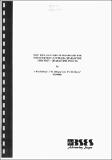Pest risk analysis of sugarcane for the Northern Australia Quarantine Strategy - Quarantine insects
| Author | FitzGibbon, F |
| Author | Allsopp, PG |
| Author | De Barro, PJ |
| Date Accessioned | 2013-05-23 |
| Date Available | 2013-05-23 |
| Issued | 1998 |
| Identifier | http://hdl.handle.net/11079/12021 |
| Abstract | The purpose of this pest risk analysis (PRA) is, firstly to identify quarantine pests and pathogens which pose a threat to sugarcane, which may enter Australia through its northern borders into the area covered by AQIS Northern Australia Quarantine Strategy (NAQS), and secondly, to identify measures which could be taken by various agencies to reduce the risks of entry or to minimise the impact of such pests should they arrive. The PRA was conducted as outlined in the FAO Standard Guidelines for Pest Risk Analysis (FAO 1996) and is one of a series of PRAs commissioned by NAWS. The other host plants covered in this series are banana, citrus, mango, cotton, grape, grain, sorghum, cucurbits, maize, pasture legumes\grasslands, eucalyptus, conifers, Acacias and palms (including coconuts). |
| Language | en |
| Publisher | BSES |
| Part of Series | BSES Internal Report; 1997 No 890 (A) CO98003 (Duplicate no) |
| Subject | Insect Pests |
| Subject | Quarantine |
| Subject | Sugarcane,Pest risk |
| Subject | Risk management |
| Subject | Biosecurity |
| Subject | Quarantine insects |
| Subject | Northern Australia Quarantine Strategy (NAQS) |
| Title | Pest risk analysis of sugarcane for the Northern Australia Quarantine Strategy - Quarantine insects |
Files in this item
This item appears in the following Collection(s)
-
Pest, disease and weed management [181]
Research outcomes: A comprehensive RD&E program that addresses existing and emerging pests, diseases and weeds, allowing sugarcane growers to manage their crops efficiently with minimal environmental impacts. An enhanced industry capacity to deal with incursions of exotic pests, diseases and weeds.

